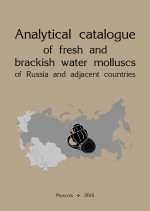В монографии обобщены данные о таксономии, номенклатуре, географическом распространении и некоторых аспектах биономии моллюсков пресных и солоноватых вод территории бывшего СССР. Всего в настоящий каталог включены данные о 424 номинальных видах класса Bivalvia и 728 номинальных видах Gastropoda. Актуальное видовое богатство водных континентальных моллюсков бывшего СССР, вероятно, существенно ниже, поскольку валидность многих из номинальных видов нуждается в дополнительном подтверждении, и в будущем часть из них может быть сведена в синонимы. Каждому виду посвящен краткий очерк, построенный по единой схеме. Также в каталоге содержатся данные о распространении всех видов моллюсков по отдельным регионам бывшего СССР, сведения о вселении инвазивных видов, информация об охранном статусе отдельных видов в соответствии с критериями МСОП. Также приведены количественные данные о сходстве водных фаун отдельных регионов бывшего СССР и результаты кластерного анализа, выполненного на их основе. Книга предназначена для специалистов в области малакологии, биогеографии, гидробиологии, а также для преподавателей и студентов высших учебных заведений. The monograph summarizes information on taxonomy, nomenclature, distribution and some aspects of bionomics of molluscs of the former USSR fresh and brackish waters. This ‘Analytical catalogue’ is a deeply improved and updated version of two previously published catalogue works (Yu.I. Kantor, A.V. Sysoev “Catalogue of molluscs of Russia and adjacent countries”, 2002, in Russian; and Yu.I. Kantor, M.V. Vinarski, A.A. Shileyko, A.V. Sysoev “Catalogue of the continental mollusks of Russia and adjacent territories”, 2010). In total, the data on 424 nominal species of Bivalvia and 728 nominal species of Gastropoda are included into this book. The actual species richness of aquatic continental molluscs of the former USSR perhaps is significantly lower since validity of many of these nominal species may be questioned and a portion of them is destined to be synonymized in future. During preparation of the book the authors tried to take into account different views on systematization of the ex- USSR aquatic molluscs and to find some correspondence between the ‘Russian’ system (founded in 1960–1970s by Ya.I. Starobogatov) and the approach followed by malacologists working outside Russia. Current approaches to the ‘species problem’ in malacology are briefly discussed. Also, the catalogue includes information about distribution of all molluscan species among large regions of the former USSR area, some data about invasions of alien species and the conservation status of indigenous taxa in accordance with IUCN Red List criteria. The quantitative estimates of faunistic similarity between aquatic malacofaunas of the ex-USSR large regions and the results of the cluster analysis carried out on the basis of these estimates are also provided. The book is addressed to malacologists, biogeographers, hydrobiologists as well as to university lecturers and students.


